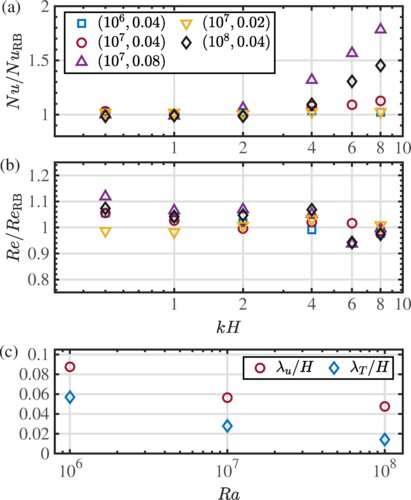(a) The Nusselt number ratio Nu/NuRB and (b) the Reynolds number ratio Re/ReRB versus the wave number kH, respectively. In (a) and (b), different symbols represent different combinations of (Ra, A/H) as indicated in the legend of (a). (c) The viscous and thermal boundary-layer thicknesses versus the Rayleigh number for the RB flow. Credit: Physical Review Letters (2023). DOI: 10.1103/PhysRevLett.130.204001
Researchers from the Department of Mechanics and Engineering Science at Peking University (PKU), led by Prof. Chen Shiyi and Prof. Yang Yantao, have recently proposed a mechanism to enhance the efficiency of heat transfer in convective turbulence. The paper has been published in Physical Review Letters, entitled "Boundary-Layer Disruption and Heat-Transfer Enhancement in Convection Turbulence by Oscillating Deformations of Boundary."
Convective turbulence, driven by gravity-induced instabilities resulting from temperature gradients, is a prevalent occurrence in various natural flows, including the atmosphere, ocean, and mantle. It is referred to as an indispensable process for both heat and mass transport and finds practical applications in heat dissipation in devices and indoor temperature control.
However, the existing methods for regulating convective turbulence suffer from several drawbacks. They only function in a limited range of parameters, demand an extremely high frequency, and consequently, the overall heat transfer enhancement is restricted.
The PKU research team's novel approach focuses on introducing oscillating deformations in the form of standing waves in a flow system where the top is at a high temperature and the bottom at a low temperature, thus effectively modulating transport efficiency.
The research results demonstrate that significant increases in heat flux can be achieved only when the amplitude of boundary oscillation approaches the thickness of the boundary layers. Notably, the dimensionless heat flux more than doubles when the dimensionless frequency precisely reaches 8. In essence, oscillating deformations of boundary can break the bottleneck of classic thermal convection in the boundary layer and open a new venue for modulating the convection turbulence.
More information: Leiqi Yuan et al, Boundary-Layer Disruption and Heat-Transfer Enhancement in Convection Turbulence by Oscillating Deformations of Boundary, Physical Review Letters (2023). DOI: 10.1103/PhysRevLett.130.204001
Journal information: Physical Review Letters
Provided by Peking University
























